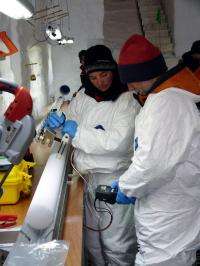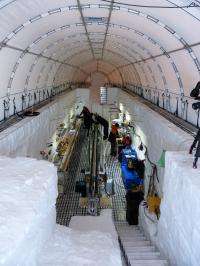Bedrock breakthrough in Antarctica

(Phys.org)—A team of scientists from nine nations, led by Victoria University's Dr Nancy Bertler, have made a huge breakthrough in Antarctica—successfully drilling more than 760m through the ice to the bedrock, on an island in the Ross Sea.
The international project has been headed up by GNS Science, Victoria University and Antarctica New Zealand.
Dr Bertler, of Victoria University's Antarctic Research Centre and GNS Science, has led the team to drill the 763m long ice core from an ice cap on Roosevelt Island in Antarctica. They completed the drilling in late December when the drill bit brought sediment up from the base of the ice sheet.
"The drill cores will provide the most detailed record of the climate history of the Ross Sea region for the last 30,000 years—the time during which the coastal margin of the Antarctic ice sheet retreated following the last great ice age," says Dr Bertler, by satellite phone from the camp on Roosevelt Island.
"I am thrilled with the team's success, which has been many years in the planning—and has involved four summers of field work doing drill site surveys, setting up the drill system and camp, as well as the drilling itself."
Analyses of the ice core, to be undertaken at the purpose-built National Ice Core Research Facility at GNS Science in 2013, will provide important new insights into how the Ross Sea region will respond to global warming, and the sediments from the base of the ice sheet might reveal what the region was like the last time Earth's climate was as warm as it is today.

Director of the Antarctic Research Centre, Professor Tim Naish, received the news by satellite phone. "The team are obviously delighted—I am extremely proud of them for successfully obtaining one of most important climate archives from Antarctica to date."
The ice drill itself was constructed by Antarctica Research Centre technologists Alex Pyne and Darcy Mandeno, working with Nelson engineering firm Pro-machining. The pair have more than 30 years experience in scientific drilling of sediments and ice in Antarctica.
The logistical support for the Roosevelt Island Ice Coring Expedition (RICE) has been provided by Antarctica New Zealand, costing more than $1 million per year.
Antarctica New Zealand Chief Executive Lou Sanson says that the support of such a major field operation nearly 1,000kms from New Zealand's Scott Base has been challenging and complex.
"This is a marquee project for Antarctica New Zealand, and we are very proud of the success of Nancy Bertler and her team."
The ice cores will be transported back to McMurdo station by air, and then by cargo ship to New Zealand in March.
A 50-strong science team from New Zealand, Australia, Denmark, Germany, Italy, China, Sweden, USA and the United Kingdom will meet in at the GNS Science ice core facility in Lower Hutt to sample the cores in May.
The team will remain at the Roosevelt Island Camp for another four weeks, as they pack up and move equipment back to Scott Base ready for their return to New Zealand.
"We are in high spirits, and can't wait to get started on analysing the more than 100,000 samples that will be taken from the ice cores," says Bertler.
Provided by Victoria University of Wellington

















